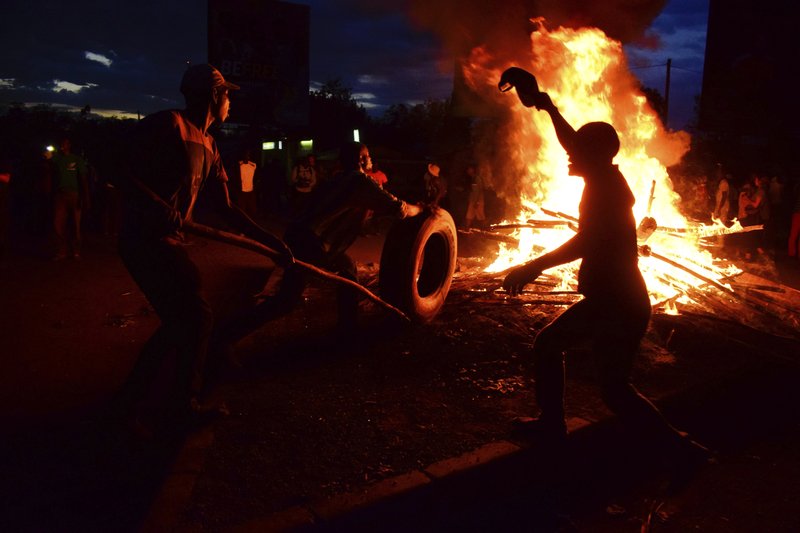After Kenya vote drama, secessionist talk enters mainstream


During Kenya’s election upheaval, a few protesters displayed images of the flag of the “People’s Republic of Kenya,” a notional breakaway state. Some posted online images of Kenya divided into two nations along ethnic lines, reflecting a growing sense of marginalization in some opposition strongholds despite some progress in allocating more rights and resources to aggrieved communities.
In another new challenge, Mombasa Gov. Hassan Joho, another governor and more than a dozen lawmakers have revived old calls for coastal counties to secede, alleging discrimination by the national government since Kenya’s independence from British rule in 1963. Critics have dismissed the call as political posturing in the wake of President Uhuru Kenyatta’s disputed election win on Oct. 26, but the rhetoric highlights the skepticism of some Kenyans about the unity of one of Africa’s most influential nations.
However unlikely, secession is “an idea that was extremely marginal, and now it’s gone mainstream,” said Abdullahi Boru, a political analyst in Kenya.
Recent independence bids in Spain’s Catalonia region and Iraq’s autonomous Kurdish area ran up against the power of the state, and the bloodshed that accompanied the path to statehood in African nations including Eritrea and South Sudan is a measure of the toll of some secessionist bids.
Separatists in Kenya are likely to encounter immense political pressures, legal obstacles and a possible crackdown by security forces even if they can organize effectively. Meanwhile, Kenyan officials note, even counties where opposition thrives continue to work with the capital, Nairobi, on development and other projects spurred by a 2010 constitution that seeks to give local areas more clout and funding.
Secession is a rallying cry in the camp of opposition leader Raila Odinga, an ethnic Luo who boycotted the October election after challenging the victory of Kenyatta, a Kikuyu, in an August vote nullified by the Supreme Court because of flaws. Odinga has said he is forming a peaceful “resistance movement.”
The October election is also being challenged in court. Odinga says yet another vote should be held within 90 days, capitalizing on the frustration of supporters who say Kikuyus and their Kalenjin allies have dominated the country for too long.
“Let them divide Kenya into two” if another election isn’t held, said Veronica Akoth, an Odinga supporter in the western city of Kisumu, an opposition stronghold. Some Kisumu protesters have chanted, “Kisumu si Kenya,” which means “Kisumu is not Kenya” in Swahili.
The slogan is a variation on “The Coast is not Kenya,” a saying that maintains coastal communities are different from the rest of the East African nation, partly because of their history as a territory under the authority of Zanzibar’s sultanate.
Joho, the governor of Mombasa County that includes the major Indian Ocean port of the same name, belongs to an opposition coalition formed by Odinga. He and his allies have indicated that their secession campaign would be lengthy, requiring consultations with community leaders. However, the governors of four out of six coastal counties (Kenya has 47 counties in total) have not joined Joho’s call.
Secessionist violence plagued Kenya shortly after independence, when security forces fought Somali insurgents seeking to join with neighboring Somalia. In the late 1990s, opposition leader Mwai Kibaki suggested secession for central Kenya after an election period marred by violence. Kibaki was elected president in 2002 and became a staunch advocate of the Kenyan state.
“At the core of the call for secession is the failure by successive governments to address the issues of historical land injustices, exclusion from development, etc. Historically, presidents in Kenya often rewarded those loyal to them with development and those who showed any signs or forms of dissent with exclusion,” Natasha Kimani, an analyst at the Chatham House research center in Britain, wrote in an email to The Associated Press.
The idea of secession, however, is unlikely to take root because Kenyans have largely embraced decentralization, seeing it “as a way to bring resources and services closer to the people,” Kimani said. She cited development successes in “marginalized areas” such as Turkana, Marsabit, Mandera and Lamu.
Kenya’s election turmoil, including violence that left dozens dead, created a “very polarized and ethnically divided environment that we haven’t seen for quite a long time,” said John Tomaszewski, regional director for Africa at the Washington-based International Republican Institute. But he doubted that secession can succeed in the near term, saying: “I don’t see that we’re at a stage yet where something like this could be carried out.”